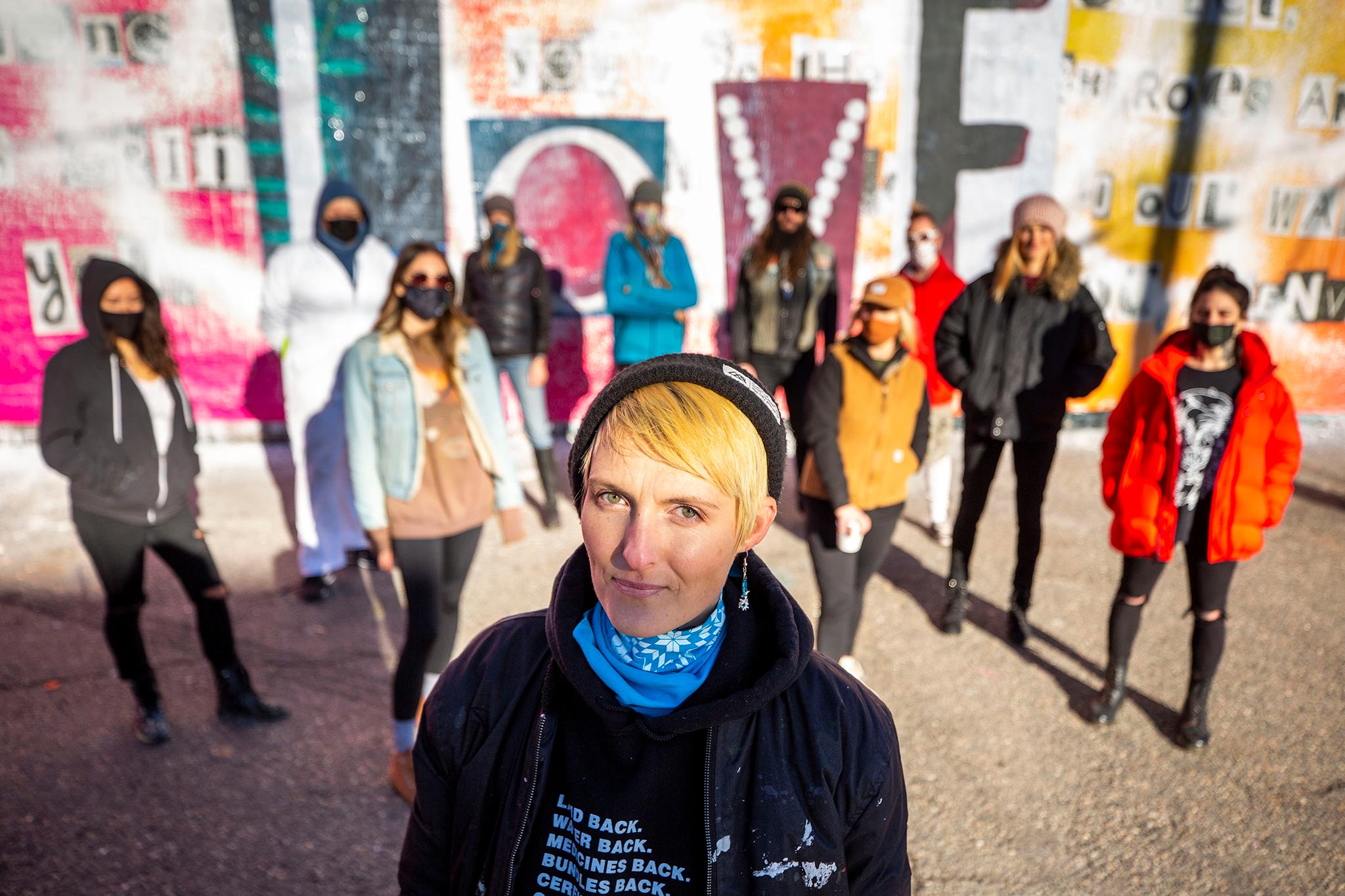This story contains graphic descriptions of sexual assault.
On September 21, one day after the 2020 CRUSH Walls had ended, Robyn Frances wrote a post on Instagram that sent shockwaves through Denver's art scene.
Frances, who goes by "Grow Love," explained why she does not participate in CRUSH anymore. The local muralist wrote that the festival's founder, Robin Munro, had sexually assaulted her and had been inappropriate with her then 8-year-old daughter.
In the weeks that followed the post, more women came forward with claims against Munro. Their stories addressed not only his alleged behavior, but the system that allowed him to continue in his position of power even though allegations against him had circulated in the art scene for years. Munro declined to be interviewed for this story but through his lawyer denied all of the allegations against him brought by Frances and others.
Denver's street art scene, they said, lacks accountability. It's controlled by gatekeepers. Within the tight-knit, opportunity-oriented community, speaking out against someone respected and in a position of authority -- such as, for example, the man who runs Colorado's premier street art festival -- can damage the accuser's career.
In early December, news broke that RiNo Art District and CRUSH Walls had parted ways. The decision came more than two months after RiNo announced that Munro had been temporarily suspended from his role in CRUSH and that the arts district planned to investigate the allegations against him. Both parties now say that their split was mutual.
Some artists have speculated the decision to sever ties with CRUSH was the result of RiNo's investigation. But the women who spoke out against Munro say RiNo never contacted them to participate in any investigation. Some of them say they're frustrated that RiNo made its decision without taking a firm public stance on the allegations and that the way the break is being characterized implies that Munro will once again have control of CRUSH.

In the last five months, Denverite has spoken to the women behind the allegations against Munro, as well as to their friends and family members, other members of the art scene, and Munro's lawyer. We've examined texts, emails, social media posts and legal documents to investigate their allegations. These women, not all of them artists, said they don't want Munro to be "canceled." They're asking for Munro to seek rehabilitation and for the systems that kept him in power to be held accountable.
Robyn
Robyn Frances was born in Denver and grew up in Jefferson County. She got her art degree at the University of Denver, and after working in studio spaces for years, she was beginning to break into the mural scene in 2017. That year was her first as a participant of CRUSH Walls.
"It was very exciting," Frances said. "As a newer mural artist, to be able to paint for CRUSH was a pretty big deal."
Founded in 2010, CRUSH is Colorado's largest and longest running urban arts festival -- the second largest is Street Wise Boulder, which was founded in 2019 and hosts less than half as many artists as CRUSH. Every year, CRUSH takes over more than 30 blocks of RiNo and the surrounding area, churning out murals that have helped grow RiNo's profile as an arts district. It's been a vehicle of self-proclaimed "uncensored" expression and a chance to drum up publicity and connections for both veteran and rising artists. It's a crowd-drawing event that leaves a colorful impression on Denver's streets for months after it ends. In 2017, CRUSH officially partnered with the RiNo Art District. It's grown in popularity and size in recent years, attracting renowned street artists from around the world.
But its critics argue that CRUSH symbolizes a problem in Denver's art scene: the commodification of street art. They say it's helped "gentrify" graffiti culture, which has long celebrated unsanctioned art on public spaces. They say the festival, which began and continues to be largely white and male, is part of actual gentrification in nearby areas like Five Points.
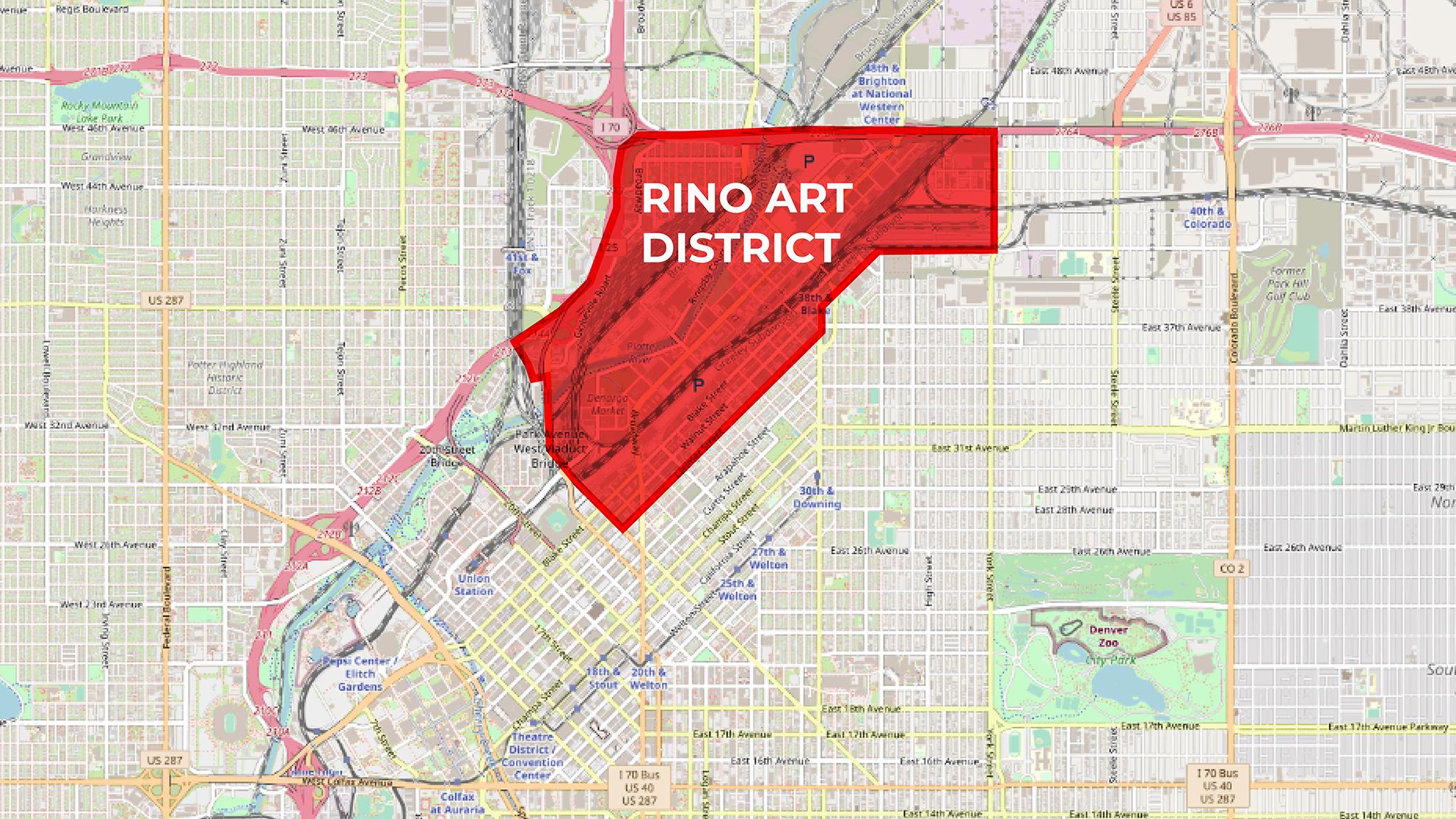
Though the city of Denver has historically cracked down on graffiti, it has in recent years celebrated sanctioned street art through its public arts program. The city and businesses around town have even hired famous muralists like Pat Milbery, who's known for his "Love This City" murals, to paint walls and other structures. CRUSH was founded with the city's support.
During her first year at the festival, Frances was given a "wall" by a friend: a rollup garage door at the Denver Rock Drill, facing the light rail off of North Williams Street and 40th Avenue. She wasn't on the official artist roster and was nervous to be painting such a big piece her first time there. But when she met Munro, she said he was very welcoming. He was impressed at how quickly she'd finished her wall and offered to walk her around and introduce her to the other artists.
"It really felt like I was getting a sneak peek into this mural world that I was super-excited to start to be creating work within," Frances said.
Munro and Frances soon started dating. She said he was charming, charismatic, sweet and attentive, often going out of his way to do nice things for her. He'd buy her little gifts, take her to nice dinners, tell her that he cared about who she was, about the hard work she put into her art, about the fact that she's a mother.
"I was totally charmed by him," she said. "I mean, he was treating me like I had never been treated in a relationship."
But looking back, she said there were red flags in their relationship that she ignored at the time. She said he told her that he would set up fake Facebook and Instagram profiles to stalk and harass people online. He'd talk about his graffiti crew, saying things like, "Nobody f**** with us because we take care of business." Frances said she later heard stories about him jumping guys with his crew.
"You could tell that he liked to hurt people in a way. Like, it made him feel powerful," she said. "I don't know why I thought he wouldn't hurt me."
She said that about two weeks into their relationship, he finally did. They'd gone out to dinner one night. While they joked and bantered, Munro brought up choking her, Frances said. She thought he was joking. They got back to his apartment and got naked. Without warning, Frances said, Munro got behind her on the bed, put his hands around her neck and started strangling her.
"I thought he was trying to kill me," she said.
Frances said she wriggled out of his grip. She grabbed her clothes and left as quickly as she could.
"I never asked him to do that," she said.
Munro maintains publicly and privately that the allegations against him are false. His attorney, Kathryn Stimson, responded to some but not all of the questions we posed about the allegations we're reporting. We've included all of her responses. We spoke to friends and family members of the women we interviewed, including Frances, who recalled them talking about the details we've included in this story around the time they happened.
Frances said she's since spoken to mutual friends who say Munro now characterizes their sexual relationship as aggressive, but consensually so. She said that it wasn't, and that encounter in particular was scary.
"How can somebody speak and act so attentively and so caring, and act like they really care about you, and then hurt you?" she said.
The next day, she realized that in her hurry she'd left her purse at his place. She didn't want to go back; she was scared he'd hurt her again. But she said she felt like Munro had the power to damage her career. He was the head of CRUSH, a well-connected person and a leader in the local arts scene.
"It's so contradictory that I would go back to his house," she said. "But I knew that I wouldn't be able to get my things if I didn't apologize. I knew that he would completely destroy my career if I didn't apologize for his violence toward me."
She messaged him, apologized, and asked to come over. When she got to his apartment, he welcomed her with a hug and told her he forgave her.
A few things were going through her mind in that moment, she said: He'd hurt her, and he could hurt her again. He could hurt her career. And she was still confused as to how someone who said he cared so much about her could hurt her. She ended up having sex with him that day.
"I think a lot of women or people who have been in sexually abusive situations, don't realize that the actions that they took in certain situations were not necessarily their choice," she said.
The same confusion and fear played in Frances' mind even after she left his house. She was afraid he'd shame her if she ended up on bad terms with him. She said she realized that to have a career as a muralist in Denver, she would have to be friendly with Munro.
Dr. Anne DePrince, a psychology professor at DU who specializes in violence-related trauma, said that it is not uncommon for victims of abuse to attempt to placate an abuser. She noted that there are lots of examples where a survivor whose future or livelihood is tangled up with the abuser might act the way Frances did.
"When someone is really connected to the person who's abusing them, there may be really strong pressure to ignore or gloss over things, or to be the person who makes the situation calmer and easier," DePrince said. "For example, survivors who might apologize, or walk back a confrontation because they're trying to keep themselves safe."
A week or two after the alleged assault, Frances was driving around downtown in an old collector truck with her then 8-year-old daughter. She knew Munro was around Larimer Street hanging out with other artists. She texted him saying they'd maybe stop by to say hi.
They met up in RiNo. Frances' daughter was lying down in the bench seat of the truck as they waited for Munro to meet them. Frances said that her daughter didn't know Munro and that they'd only met in passing at CRUSH.
"She doesn't know this person. This isn't family. This isn't a man in her life," she said.
When he got to the car, he opened the passenger side door and started ruffling the girl's hair and tickling her. As he tickled her, Frances said his crotch was against her head on the seat. He kept tickling her and laughing. Her daughter was laughing, too, but the situation felt "weird" to Frances. She told Munro to come over to her side of the car. She got out and closed the door. She could see that he was drunk. She didn't know what to do, so she gave him a hug. As she was hugging him, she said, she felt that he had an erection.
Frances said she freaked out. She got in her car and left. As soon as they started driving away, her daughter started crying, saying "Mom, that wasn't right."
"It was one of the most awful experiences in my life," Frances said. "I said, this guy's not right in the head. What just happened was not f****** normal."
Frances texted Munro right away. She demanded to know what had just happened and asked if he was a pedophile. He said he wasn't. It quickly occurred to Frances that she would have to ease things over. She apologized for her delivery, explaining that she was trying to protect her daughter.
"I apologized at that time because I didn't want my career to be ruined," she said. "I wanted to still participate in CRUSH because I felt it was the only way to be a relevant mural artist in Denver."
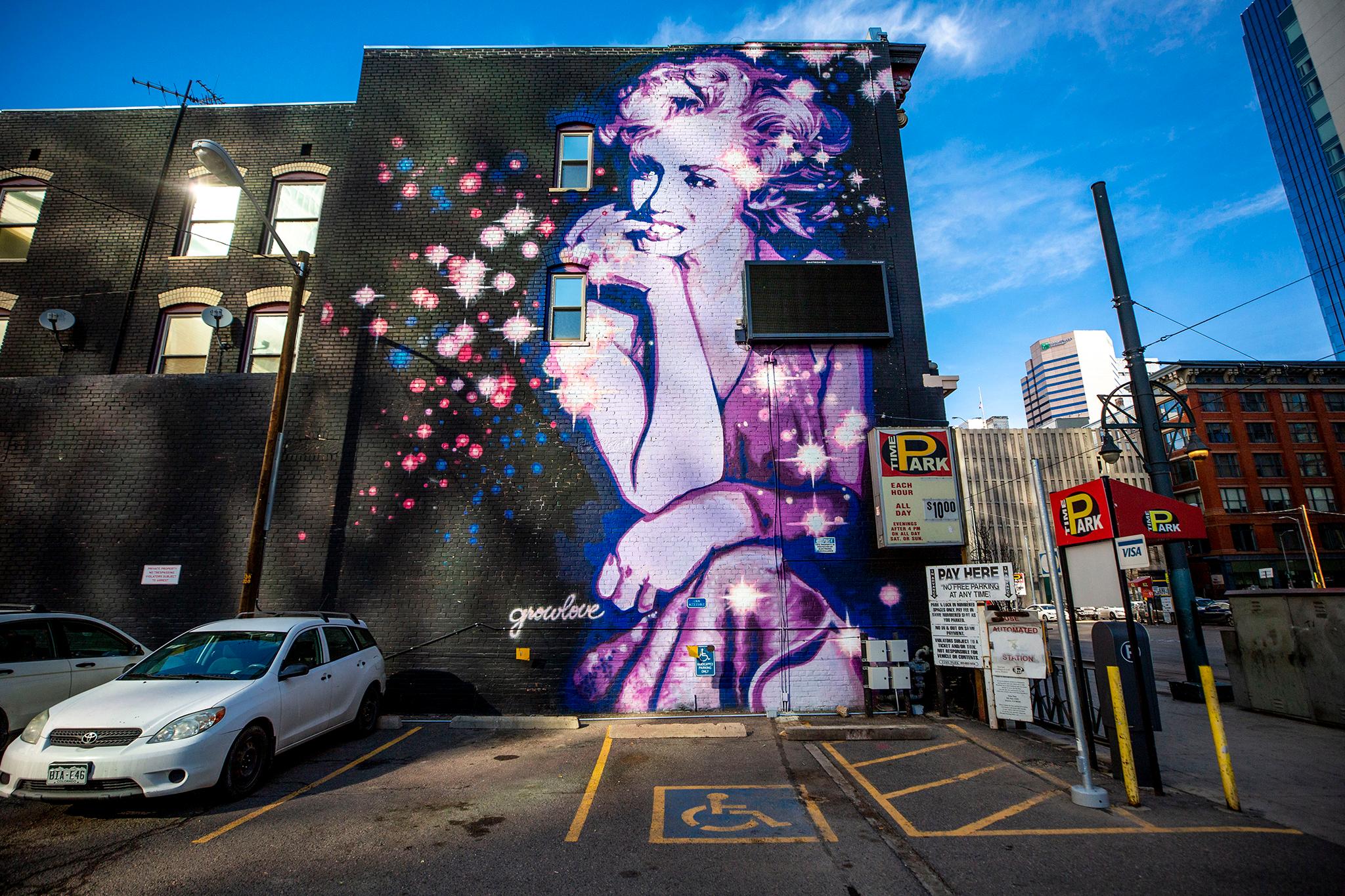
Through his attorney, Munro denied Frances' allegations, and on December 9, via Instagram stories, Munro shared messages between himself and Frances from 2017, when she apologized to him for confronting him about the encounter with her daughter.
"Mr. Munro has never inappropriately sexually touched a child," said Stimson in a statement. "This allegation is false, and Grow Love apologized to him over text message for falsely accusing him of this horrible crime. Mr. Munro ruffled the child's hair while she was seat-belted in a truck. Nothing else occurred."
Munro's criminal record shows a few DUI convictions, but no crimes of violence.
Frances decided after the alleged encounter with her daughter that she needed to stay away from Munro. But Stimson said Munro was the one to break off the relationship, over text when Frances confronted him. Frances did not reach out to Munro again after that exchange, except once, that December, to tell him she'd repaired a mural of his that she'd tagged without realizing whose it was.
The events of those weeks stuck with her for a long time and helped shape her career and identity as an artist. Her old artist moniker was "Ava." Now, she goes by the name Grow Love, which she said is an affirmation, a mission, to utilize her artistic ability to create more love in the world.
"The name came out of pain," she said. "It came out of a very, very deep sadness, but out of a place of hope."
A lot of her art in the last few years has featured nude female figures in positions of strength. She said they're a reference to the history of exploitation of the female figure in the art world and a statement that no woman should be afraid to own her body. In 2018, she founded an organization called Grow Love International to support women navigating careers in the mural arts. She said her work has now evolved to be more about nurturing the Earth and nurturing community.
She does not think much about her assigned birth name, one that she shares with Munro.
"I believe your moniker stands for the person that you are," she said. "So that does definitely shed light on the way people choose their names."
Jess
Jessica Vaughan hadn't given Robin Munro much thought until she met Robyn Frances.
In 2018, Frances happened to walk into the gym where Vaughan worked. Vaughan was assigned to train her, and they got to chatting. Frances mentioned she was a muralist, and Vaughan mentioned that she'd once dated a muralist. It was then that they realized they shared an ex: Munro.
Frances told her that Munro had sexually assaulted her and that he'd been inappropriate with her daughter. But Vaughan wasn't ready to share her story, hinting only that something bad had happened between them. Still, Frances and Vaughan instantly bonded.
Vaughan had once worked as a dancer at a strip club. She said she regularly faced harassment and abuse on the job and that people would try to take advantage of her. She'd learned to employ a method of stuffing all of that into an imaginary box that she never opened. If she pretended it wasn't there, she didn't need to think about it. She said that's how she dealt with what Munro had done to her, too.
"At that point, when I met (Frances), I'd stuffed the fact that he raped me so far down that I was just like, I'm taking this s*** to my grave," she said.
Time passed between Frances and Vaughan's initial meeting. Then one day, Frances came in for training, worked up about a crazy dream she'd had. She said that in the dream, Munro had raped her.
"She told me that she would never forget the look on my face," Vaughan said. "Because I was like, oh, but he raped me."

It was the first time Vaughan had ever told anyone, and it was emotional for her. She said she felt awful knowing that Frances had dated Munro after her and that she might've done something to prevent him from hurting her had she known. She said it felt good to finally be honest about it. It was a sort of release.
"There's something that happens when you say that s*** out loud," Vaughan said.
She'd opened the imaginary box, and now she had to deal with what was inside.
Vaughan met Munro through mutual friends at CRUSH in 2015. They hung out at the festival, and he taught her different painting techniques. They bonded over a shared interest in cooking.
"He wasn't even, like, a creepy guy that hit on women," she said. "He was just a really nice guy. At the time."
He messaged her a few weeks later, asking her to hang out.
It was fun, romantic. They didn't have sex the first night, but they were intimate pretty quickly, she said.
"He was aggressive about being physical, but not in a violent way. Just more so about, like, this is happening," Vaughan said.
She really liked that he seemed to care about the community. He was a leader in the arts scene. He was spiritual; he seemed to think about things on a different level, talking about the universe.
"He's kind of created this image for himself -- like 'Dreadgod,' you know," she said, referring to Munro's alias. "He's very enchanting because of all of the things that he creates."
She said that at the time, she didn't think of his artist moniker as anything more than an alter ego.
"Hindsight is 20/20, you know. Like, now, looking back I'm like, 'Oh, you think you're this powerful, ominous man. Like, godlike, but also, people should dread you a little bit.' He wants people to be afraid of him," she said.
He was sober at the time they were together, she said. He told her that when he drank, he became someone he didn't like, and that he had relatives who were violent alcoholics he didn't want to emulate.
There were some strange moments, Vaughan said. Early in their relationship, Munro would talk about his exes -- how crazy they were and how he liked them that way.
"Sometimes when we would have sex, he would mention one of his ex-girlfriends that would cut herself during sex," she said. "He never asked me to do it. But it was just a weird thing to bring up."
He'd try to get her to stop dancing, offering to let her be his assistant instead.
"He would just make it very apparent that he needed to be the number-one man in my life. And he needed to control things. And he wanted to have babies. And I didn't want to have babies and 'Oh, well, you will want babies,'" she said.

Vaughan said he raped her three to four weeks into their relationship. That night, they'd planned to stay in, opting for dinner and a movie. They rented the movie "Dope" from Redbox. Pretty soon after starting the movie, Munro started to initiate intimacy.
"I remember just kind of wanting to watch the movie and kind of, like, kind of pushing him off a little bit at first," she said. "But I was convinced soon after. And it was still consensual at that point."
Vaughan said Munro took off his belt, had her turn around, and then hit her with it. She said that was still consensual. Then he hit her harder and harder still, inflicting serious pain, she said.
"Immediately I turned around. I was like, 'No, I don't want to do this anymore.' And he convinced me that he wouldn't hit me hard again. And convinced me to turn back around. And so I did."
He hit her again, just as hard, if not harder, she said.
She turned around and said no, she was done, she didn't want to do this anymore, she recalled. He started kissing her, trying to convince her to turn back around. She kept saying no. He picked her up and turned her around, kissing her genital area. And again, she turned around and said no. He picked her up again.
Her mind was racing. She recalled thinking that he had already hurt her and wasn't stopping, no matter how many times she'd said no.
"I might as well lean into this, as opposed to not, because I'm scared of what could happen if I don't," she recalled thinking. "So I faked an orgasm on the couch so that things would move faster. And then we went into his room."
He put her underneath him and had sex with her. Again, she said, she faked it so that it would end.
"I remember that night I was like... I didn't feel good. And I cried myself to sleep a little bit," she said. "It took me a little bit of time to really figure out what happened because I was like, 'He's my boyfriend.' It was just... it was really confusing."
DePrince said that often, people who hear stories of sexual assault react by saying that if they were in the situation, they'd have done it differently -- that they would have fought back, or left, or called the police.
"There's no single right way to respond to a trauma, including sexual assault," DePrince said.
She said trauma triggers a biological response wherein stress hormones start flowing through the victim's system.
"Sometimes our brains and bodies go on a sort of autopilot to just get through the situation," she said. "So for some women, that might look like fighting back. But fighting back can also increase the danger in the situation. So for other women, it might look like being passive or appearing to enjoy or playing along with whatever's happening. But it's really important to remember that that's in the service of trying to survive this trauma that's unfolding in real time."
A study conducted by the University of Massachusetts with the support of the National Institute of Justice looked at sexual assault cases reported across six jurisdictions in the U.S. The study found that less than 19 percent of sexual assault reports led to an arrest, and only about 6.6 percent of those arrests led to a conviction. DePrince said this study can help explain why sexual assault victims might hesitate to seek help from the criminal justice system.
"Sexual assault remains one of the most underreported crimes, so the idea that when sexual assault happens, people pick up the phone and call the police, is just not true," DePrince said. "There's no reason to think that because women didn't do something right away, it's not true."
Reasons for hesitating to call the police might include emotional attachment to the person or fear of not being believed.
"It's brutal to acknowledge that the person that is supposed to care most about you is behaving abusively to you," said Margaret Abrams, executive director of the Rose Andom Center, a resource center for domestic violence victims in Denver. "So to have to disclose that can be very embarrassing."
Abrams said that it can also be scary for victims to have to confront their trauma in a public forum and to have to file police reports and potentially go to court.
"They don't necessarily want to involve the criminal justice system," she said. "They want the abusive behaviors to end."
The next morning, Munro woke up, kissed Vaughan, and asked if she wanted breakfast.
"I still felt kind of weird and really s*****," Vaughan said, like there was a hole in the pit of her stomach. "But he woke up and acted like everything was normal and everything was fine. And I was like, OK, yeah, I guess everything's fine."
They ate, and she went home. She tried to process what had happened. Did he rape her? Did she say yes at some point? She hadn't been drinking. Why would someone she trusted do that?
"I was trying to also convince myself that, 'Oh, he's my boyfriend, he wouldn't do that to me. We've had consensual sex so many times before,'" she said. "And I was almost trying to give him excuses, too, which upset me, because I knew in my mind, I knew what happened."
We spoke to some of Vaughn's friends and family members, who recalled listening to her allegations against Munro months before she decided to go public. But she didn't tell anyone her story before she told Frances in 2018. She thought that no one would believe her because she was a stripper. No one would believe that her boyfriend -- a nice, charismatic, well-respected person, a father with a young daughter -- had raped her, she said. He wouldn't do that to a woman, she thought. So she stuffed it down, buried it, ignored it so that no one would find out and so that she could maybe forget about it, too. Munro's attorney denied that he raped Vaughn.
Vaughn and Munro dated for about a month after that. But she did start to back away.
A couple of weeks after he allegedly raped her, she was on vacation in New Orleans when he called her. She said he told her about how he and his buddies, the group she called his "paint gang," beat up a guy they'd had a disagreement with outside of an art gallery.
"It sounded like he was bragging about it, that he and his four or three friends jumped the guy," she said. "He got off on it. And he was like, 'Oh, yeah, this guy's a douchebag, and we just beat him up.'"
She told him it made her uncomfortable and asked why they would do that.
"He kind of got weird and would backtrack and, like, kind of glaze over his story in a different way," Vaughan said.
She broke up with Munro shortly after that, telling him she didn't think they were compatible. She was relieved that he took it well.
"I was really excited," she said. "I was really happy that we weren't going to be together anymore. And honestly, that was like a sense of relief, knowing that he couldn't rape me again."
After their breakup, they bumped into each other a few times. Munro would ask her to grab coffee or go for a bike ride, and each time she said no.
But, she said, he painted a few murals of her.
"I remember when we were together, he would tell me that he would never paint his girlfriends or paint his ex-girlfriends. He would never paint any woman on a wall that he was dating," she said.
But after they broke up, she said he painted her on a wall of a huge car wash on Colfax Avenue: a girl with dyed red hair and a gas mask. It matched a picture she'd sent him when she was on vacation. A few months later, he painted another woman who looked like her, in RiNo.
"So, like, after we broke up, he went on this weird streak of, like, making art of me," she said.
Aside from those run-ins, she hadn't confronted the memory of their relationship much. But after meeting Frances, she learned to face it instead of turning away from it. She's done a lot of crying. She said she's worked to find grace for herself, to recognize that it wasn't her fault, to forgive herself for not confronting what had happened for so long, for not telling anyone.
"It's not necessarily an easy thing to come to terms with," she said.
After Vaughan told her about the rape, Frances started telling people in the art community about Munro in 2018, a year after the #MeToo movement started.
She'd warn community members, in passing conversations and through direct messages that she shared with Denverite for this story, to be careful around Munro, that he'd assaulted her, that he was inappropriate with her daughter, and that he'd raped her friend.
She was still a newer artist in the mural scene with little clout, but she felt she had to do something.
"I don't want other people to get hurt," Frances said. "That's the whole reason I'm talking. I'm risking my f****** whole career, just so that this person doesn't hurt any more people."
She was worried that someone from Munro's graffiti gang would come after her for speaking out against him.
"I literally slept with a f****** knife under my pillow for, like, eight months because I thought he would come to my house or send somebody to come hurt me," she said. "It was really scary."
In 2018, Frances painted at Art Basel, a street art festival in Miami. Munro was there, too. When he came up in conversation in Miami, Frances would warn people about him. Frances showed Denverite an email Munro sent her during that festival, saying that what she was doing was "called slander." He said he was in Miami with his relatives if she wanted to get together and have a conversation. She told him to stop contacting her, and said that he hasn't since.
Frances said when she initially started coming forward in 2018, people in the community ignored her.
"Deep down inside, I thought, why are all these people protecting him?" she said. "Why are all these people protecting his violence? To me, this was completely unfathomable."
Before she went public, she was working constantly. She got invited to art events, to participate in projects and to join collaborations. Afterward, she said, she started losing opportunities. People treated her story like an issue to take a side on: Robyn's or Robin's. Artists she'd once considered friends stopped inviting her to things or stopped talking to her altogether.
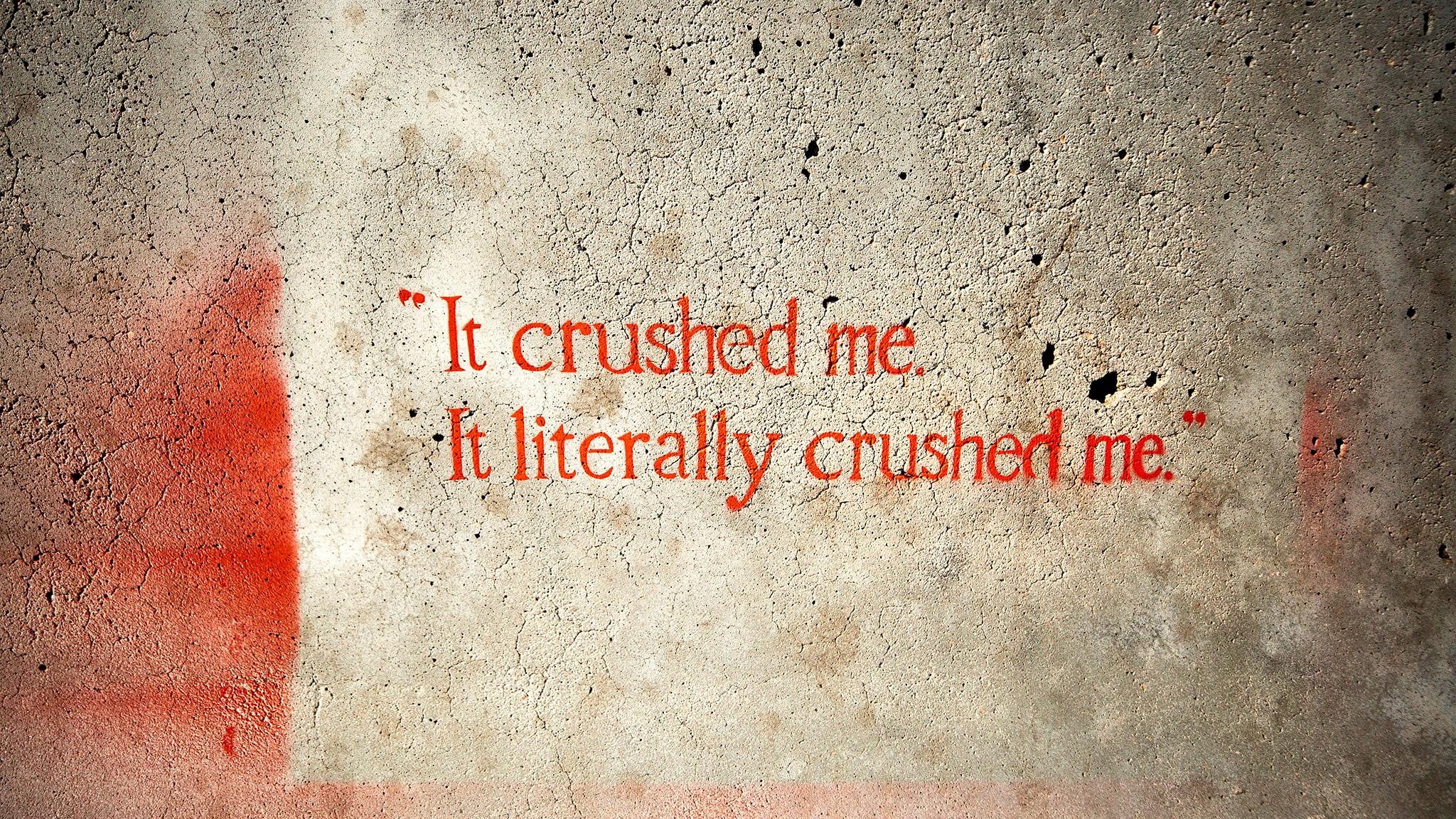
"It was, like, everyone cut me off," she said. "It crushed me. It literally crushed me."
The women we spoke to for this story who are involved in the street art scene said their community is all about relationships. Artists hire other artists. Artists promote other artists on social media. Artists refer other artists for projects. Artists pick artists to collaborate with. It's an interwoven network of friends and allies who let one another know about opportunities.
Munro is deeply embedded in the community, Frances said. He is a leader in it.
"His word is respected, and so he could say anything about anybody and everybody will believe it," she said. "And that's the thing. There's no accountability. He's just this sick person running rampant in Denver."
Over the last few years, Frances has worked to rebuild her career without relying on the community. She couldn't go into spaces where Munro might be or form relationships with galleries or community members who might interact with him.
"I had to start over completely," she said. "I felt very alone. It was very isolating."
But she's managed to make a name for herself in Denver. In the summer of 2020, Frances helped organize the first Babe Walls festival. The all-women and nonbinary mural and public art festival is meant to be the antithesis of CRUSH, Frances said: a celebration of women and nonbinary artists, and a safe community for them to support one another, to collaborate and to share opportunities.
"We wanted to create space for women to create street art," said Alexandrea Pangburn, Babe Walls' founder and a RiNo Art District staff member. "Women who felt like they didn't have that space."

Babe Walls launched in Westminster in August of 2020. Frances felt on top of the world. She was working in a supportive environment with other women artists.
Then, Munro showed up to Babe Walls.
He was there under the invitation of Pangburn, who had heard Frances' story but had been under the impression that Frances and Munro had settled their differences. She said she'd seen Frances and Munro in close proximity at a Babe Walls gallery show earlier that year. Frances said that she did not greet him at the event.
When asked about Munro's presence at Babe Walls, Pangburn said she's since learned a lot about putting on the festival.
"Any Babe Walls events going forward, we have made a conscious effort that security will be a higher priority," she said.
During the festival, another artist invited Munro to the wall Frances shared with two muralists, on the corner of 71st Avenue and Hooker Street, a couple of blocks from RTD's Westminster Station. That artist invited him to paint on it, to show them all a certain technique. Frances said that the women at the wall, all of whom Frances had told her story to, started chumming it up with him.
"It was, like, the worst nightmare," she said.
She felt like she couldn't escape him. Here he was in her space, a space that was meant to be safe. He was painting on her own wall. She was shaking. She ended up leaving the festival.
"It just seemed crazy to me that nobody could be in the right frame of mind to say, why are we inviting this person who was violent to her into her space?" she said. "Either, one, they never believed me, or two, they don't care. And they're not willing to protect the other artists in their community."
She realized then that it had to stop. She wondered what it would take for people to listen, to not push things under the rug. She knew that many of the Babe Walls participants were going to be a part of CRUSH. She felt that Munro shouldn't be in a leadership position around women and children.
"I really, really put my foot down," she said. "I said, I am a leader in this artist community. And this is happening to me. And I know that this must be happening to other people, and I will not stand for it."
On September 21, 2020, Frances posted to Instagram about why she doesn't participate in CRUSH. The response this time was much different from the response she received in 2018. Other women shared their experiences in the comments of her post. Some individuals reached out to her, and some created anonymous accounts to do so, in direct messages Denverite has reviewed. Messages show that at least five women contacted her about violent or otherwise abusive encounters they said they'd had with Munro. Some men messaged her to share negative experiences with Munro. RiNo Art District released a statement that Munro had been suspended from CRUSH and that the allegations were being investigated. Some artists even chimed in with their support for Frances.
"Coming forward again, and having the complete opposite reaction, is f****** wonderful," Frances said. "I feel more free than I ever have. And I feel like a lot of other people who are contacting me feel the same way."
Vaughan was at work when she saw Frances' post and the comments. She's not much of a crier, but she said she lost it when she saw the stories of women who said Munro had hurt them. Vaughan said they were all so similar: women who had been in what were initially consensual relationships with him, whom he then acted violently toward. She said her tears stemmed from guilt for not having spoken up but also from relief that she wasn't the only one.
She spoke to Frances on the phone, and Frances fired her up. She said she was speaking out because of Vaughan's expression when Frances told her about that dream.
"She was like, 'Jess, I'll never forget the look on your face. And that's why I'm doing this.' She's like, 'I'm doing this for you,'" Vaughan told Denverite, fighting tears. She said it was Frances' courage and strength that encouraged her to speak out.
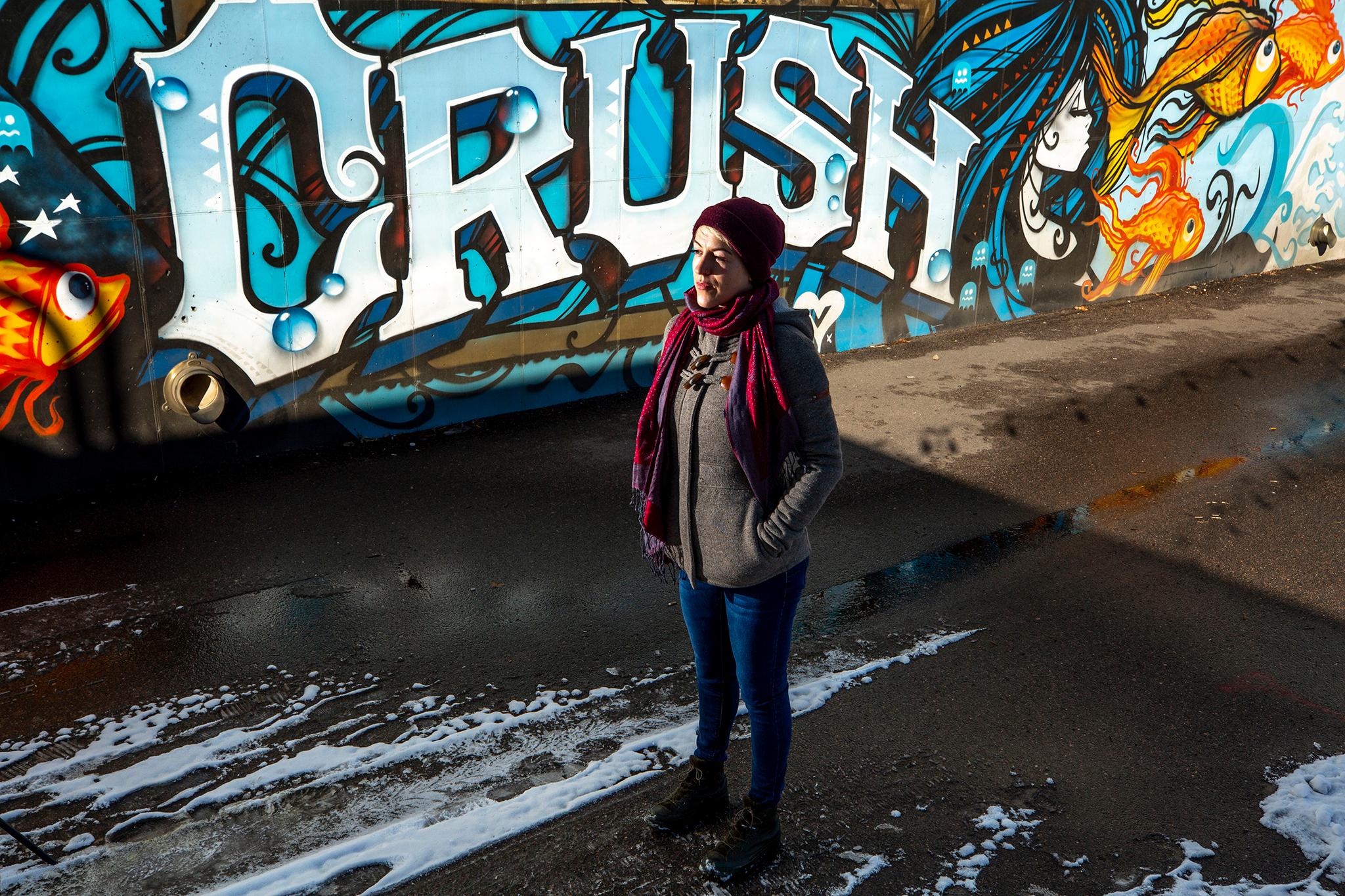
She then wrote her story out on notes on her phone, sitting with it a while, editing. She knew she needed to write it out in graphic detail so that people would believe her. She also wanted her post to send a message to other survivors that they weren't alone. She posted her story to Instagram the next day.
"I was absolutely terrified," she said. "I don't know if people were gonna believe me. Like, now I'm putting my face to this."
She thought about Munro and the graffiti gang she said he's part of.
"I'm still scared someone's going to come and be violent towards me as I'm walking home," she said.
But the post got a positive response. People believed her. They were supportive.
"I cried a lot. It's been an emotional month," she said. "But it was weird, because I do remember telling people, like, Thank you for believing me. Which just is a weird thing to say, but that's the thing that I was so afraid of. I felt so loved and supported by so many people, that I was like, OK, this is going to be OK. No matter what happens here, everything is going to be OK."
Several of the women we spoke to for this story said they were also victims of psychological abuse carried out by Munro.
Almost a decade ago, one of those women, who asked to remain anonymous for this story, told her mom that she had a strange feeling she'd see Munro's face on the news one day for committing a crime. (It's Denverite's policy not to name victims of sexual assault without their permission.)
In December 2020, after nine years of trying to put the memories of their relationship behind her, she was scrolling through Facebook when she stumbled across Munro's name in a Westword story. She learned that RiNo had cut ties with Munro after he was accused of sexual assault by several women. She realized these women must've dated him after her.
"I felt so bad. Like, I should have done more. What more could I have done to prevent these kinds of things from happening to other women?" she said. "But legally speaking I don't really think I ever had a leg to stand on."
The woman was actively involved in the music industry. She met Munro through mutual friends in 2009 and kept bumping into him at hip-hop and art shows. They started dating in the fall of 2010.
"I've never done heroin or meth or anything, but I guess that's how I would have described our relationship," she said. "When things were good, they were really good. But when they were bad, they were really, really, really bad."
He seemed to have it all together. He had a nice car, a daughter from a previous relationship, and her parents really liked him. But things gradually unraveled.
"As stupid and ignorant as it sounds, I almost would have preferred that he started out being violent, because I would have left a lot sooner," she said. "The mind games and the emotional abuse and manipulation was something that nobody could see. But it affected me way more than being choked, or being thrown against the wall, or me locking the doors so he couldn't get in the room."
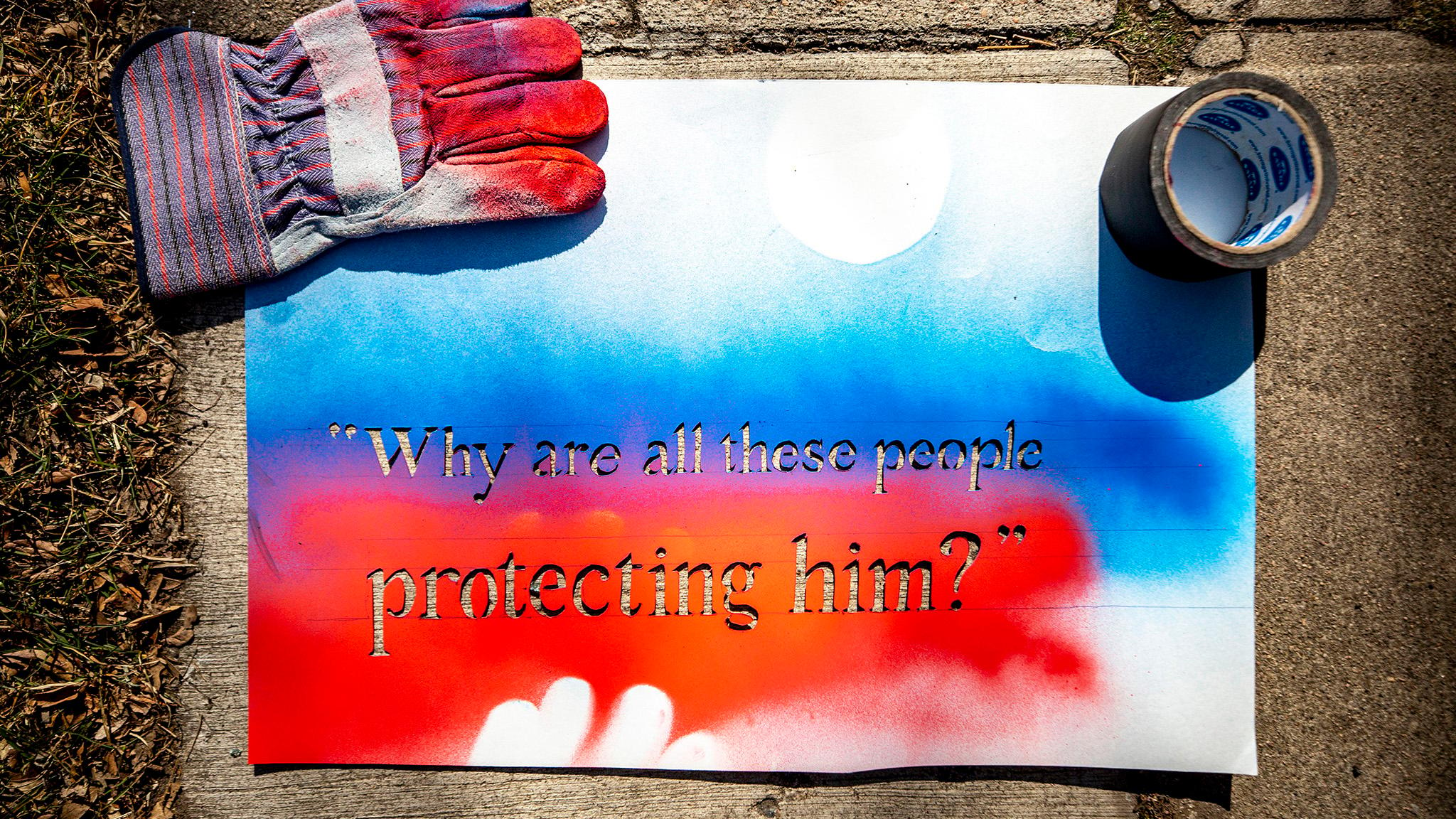
When presented with the woman's claims, Stimson, Munro's attorney, said that each one is "without merit and unsubstantiated." We have spoken to some of the woman's friends and family members, who said they witnessed firsthand some events in this story. They said she told them about other acts of abuse around the time that they happened. We have also examined texts between Munro and the woman corroborating some of the events of the story, as well as dated workbook entries she completed while in therapy for relationship abuse shortly after their 2011 breakup that specifically refer to Munro.
The woman said Munro would bring up his past relationships and the things his exes had been willing to do during sex as a way to make her feel like a prude. He often accused her of cheating and would go through her phone. He pressured her to stop seeing her male friends, then her female friends. She started seeing her family less and less as he pulled her further into the relationship.
DePrince said isolation is a common entry point into an abusive relationship.
"We certainly hear from women about patterns where a partner becomes very coercive or controlling," she said. "That might start as sort of psychological coercion, and putting pressure on women to pull away from friends, to spend all their time and invest all their energy into this particular relationship so that women end up potentially alienated or just sort of disconnected from other support."
The woman said that any time they showed up to an event together, she felt like she was there to be arm candy, to make him look good. He would then leave her alone for long periods of time. If she started making friends, he'd ignore her the rest of the night. She said that when they got home, he'd scream at her, telling her how worthless she was and how she wasn't supportive of him.
"When he would get angry, he got really angry," she said. "It was scary, to the point where I would just shut down and either not respond or just profusely apologize even when I knew I didn't do anything wrong."
Things gradually became violent, she said. She said she hadn't ever processed the fact that he'd forcibly choked her until she heard Frances' story.
"That brought flashbacks back up, because he did that to me during sexual encounters. And now I have a major fear of guys putting their hands anywhere near my neck or my face," she said. "If a guy gets any kind of aggressive with me, I shut down, and I run away."
She said she can't wear turtlenecks or anything tight around her neck.
She said that in one instance, after a fight, he came home at three in the morning, screaming at her. She said Munro started hitting her with a pillow and throwing things at her. She ran out of the house to get away from him. He continued throwing things at her as she left. She said he locked her out of the house. Her house keys were locked inside, so she ended up having to drive to her parents' house at four or five in the morning (her mother confirmed this to Denverite).
"I feel like such a f****** idiot, bringing this stuff back up," she said. "Because I'm looking at it and each situation like, Why did I stay?"
That's a question people often ask when they hear about intimate partner violence: Why would someone stay in an abusive relationship?
"It's the wrong question," DePrince said. "The question we should be asking ourselves is, why do people abuse? And how do we change that so that the onus isn't on survivors to make daily decisions, but the onus is on all of us not to be abusing and harming people we're in relationships with."
She said there are a number of reasons someone might not leave an abusive relationship right away.
"It may take a while to recognize that they're being harmed, that abuse is happening. And they might not have the financial resources to leave, especially when money or work is tied up with the abuser," DePrince said. "They may have emotional connections and ties to the abusers. We can't just shut off our attachment and emotion like a light switch."
The woman did try to leave several times. Each time, Munro would find a way to drag her back, she said. She remembered once trying to leave a goodbye note, including in it that one of his cats needed to go to the vet.
"He called me or texted me and was like, 'You're such a f****** b****. Like, how could you f****** leave when my cat is dying?'" She went back to him, and the cat died that night.
She finally broke up with him for good in the fall of 2011. Her brother recently reminded her that when she did, Munro threatened to leave a bag of dead puppies on her doorstep.
She said she ended up sleeping with Munro once more after they broke up. That's how she got pregnant.
She wanted to keep the baby. But when she told Munro she was pregnant, he tried getting back together with her. She was worried about the possibility of him being in her life forever.
She tried to get Munro to go to a counselor who specializes in abusive relationships. He wouldn't go.
She thought everything over, thought about what it would be like to be tethered to Munro for the rest of her life through this baby. She didn't want an abortion, but she felt she had no choice.
"I was like, If I don't end this, I'm probably gonna end up killing myself," she said.
She ended the pregnancy and told Munro she had a miscarriage. She said that for years she beat herself up for getting an abortion. Shortly after they broke up, she started having panic attacks. She said she was prescribed benzodiazepines and went through 32 weeks of counseling, for three hours a week.
She said she stopped showing up to arts events because she was afraid of Munro. She said she'd talked to some friends in the art community about the breakup and about how Munro had treated her. Some of them didn't believe her. Others believed her but chose to maintain relationships with Munro so as not to risk their careers. She said she's frustrated, especially, that the men who know him aren't willing to speak up.
"They all know," she said. "But they weren't doing anything because they don't want to be out of the cool kid club."
The same day in September that Grow Love posted about Munro, Hiero Veiga, a muralist who is best known locally for his work memorializing Black and brown victims of police violence in murals through the "Spray Their Name" campaign, posted a message on Instagram supporting Munro.
"Ayo, shoutout to @_dreadgod_ for another amazing @thecrushwalls event and holding down the culture. Even through all the bull shit the event turned out beautifully," Veiga said in the post. "You are an amazing humanbeing (sic) and built like no other. I love you, I got you and most importantly, I stand with you."
Veiga, who is from Florida but participates in CRUSH and frequently paints in Denver, did not respond to a request to comment for this story.
We reached out to nineteen prominent male artists in the art scene and nine prominent female artists to ask what they made of the allegations and if they would continue to work with Munro. The few who replied said they did not feel comfortable commenting on the allegations on the record. Many said that they didn't want to get involved, or that they only engage with artists on a professional level. Some said they did not know the parties involved well enough to comment. Some cited relationships with the parties involved as reasons for not speaking.
Only two artists -- Lindee Zimmer and Robert Gray -- agreed to comment for this piece. Zimmer said she believed the women and that she would not participate in CRUSH again. Gray, who co-founded the Black Love Mural Festival, an all-Black mural group dedicated to improving curatorial diversity in the art scene, said he won't participate in CRUSH 2021 because he'll be working to build his own festival. He does think that other artists will continue to support Munro, calling him a leader in the scene with many close relationships.
Munro intends to continue to operate CRUSH, Stimson said.
"Recently, the RiNo arts district returned CRUSH Walls to Mr. Munro, its founder and creator," she said in a statement. "As has been the case for years, artists selected to participate in CRUSH Walls are selected by a committee -- not by Mr. Munro. Mr. Munro looks forward to growing CRUSH in RiNo and throughout the city."
It is unclear what Munro's leadership role in CRUSH will look like. When asked what his responsibilities would be and whether Munro would be the one hiring the committee in charge of selecting participating artists, Stimson said that CRUSH is "his" but that she didn't understand the workings of the festival well enough to comment on his specific responsibilities.
Stimson said Munro has had consensual sexual relationships with different women involved in the arts community.
"A review of text messages between Mr. Munro and different women corroborates the relationships were consensual," she said.
All the women we spoke to for this story said their relationships with Munro began as consensual. When asked to provide texts or other evidence disproving the list of claims, Stimson shared the texts in which Frances backtracked her confrontation regarding Munro's behavior with her daughter. Stimson said she also had texts from one other woman who does not appear in the story that illustrate that the woman continued to maintain a sexual relationship with Munro after alleged abuse. We have spoken with that woman who said, as did some of the other women we interviewed, that she didn't fully register the abuse as it was happening.
Since the women have come forward, Denverite has spoken to other members of the arts community who said Munro's abusive behavior extends beyond intimate partner violence. These individuals asked to remain anonymous for this story, citing concerns over their careers and reputations or fear of being retaliated against by Munro. People said that they've been harassed and intimidated by Munro and that their clients have been harassed by him.
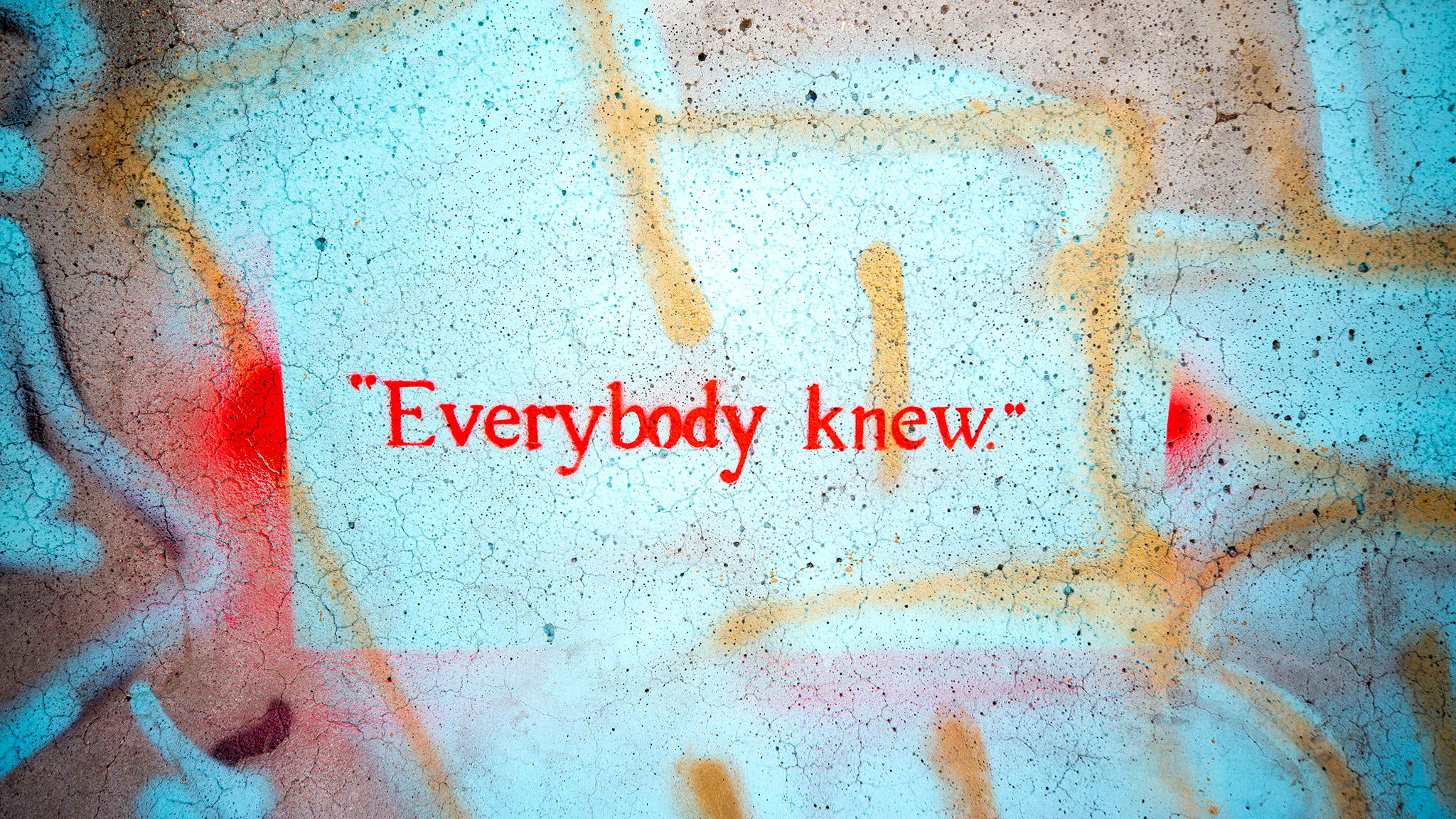
"Indeed, Mr. Munro is an artist and is at times critical of other people's work -- as is encouraged in our society," Stimson said in a statement. "He has never been violent or retaliated against anyone."
Shannon Galpin participated in CRUSH in 2018 and 2019 but didn't interact with Munro until 2019. She said that when she asked Munro for supplies and materials for her wall, he screamed at her in front of other artists, and that he frequently drove by her wall in his golf cart to make belittling and intimidating remarks.
"I know abuse when I see it," she said. "And I think the problem is that a lot of people in Denver and in Colorado don't."
She said she spoke to other artists about her experience with Munro. People told her, that's just what he's like.
"Everybody knew," she said. And if the knowledge was so widespread, "then what the hell is he still doing in power?"
Galpin travels around the world for her social justice and art work. She said that Denver's arts scene is abnormal. The culture of abuse and bullying goes beyond any one person.
"It's not just Robin vs. Robyn. It's not just him, it's his crew. It's men being bullied. It's systemic," she said.
She said that women historically have been shut out of public spaces and that their bodies and voices are policed and limited to the male gaze.
"We're literally doing that with street art: what walls we can be on, where we can be, and where we can't be," Galpin said.

Two months before RiNo announced it was severing ties with CRUSH, the art district published a since-deleted Instagram post announcing it planned to investigate the assault allegations against Munro. In December, Munro's attorney told Denverite that "After a complete investigation, including review of all communications between Mr. Munro and the online accusers, it is readily apparent that the allegations against Mr. Munro are demonstrably false."
But the women we spoke to for this story said they were never interviewed as part of an investigation, by RiNo or anyone else. When pressed for details about whether an investigation happened and what it would have entailed, including who would oversee it, who would be interviewed, who would do the interviewing, Tracy Weil, the founder of RiNo Art District, declined to comment.
The women we spoke to for this story said that at least one RiNo Art District staff member knew about some of the allegations against Munro before Grow Love's September 2020 post. When asked whether anybody on RiNo's board or staff knew about the allegations, and what their reasons were for maintaining their relationship with Munro, Weil declined to comment.
Based on messages Denverite has reviewed, Munro is contacting other artists with claims that RiNo "settled," that his "innocence was proven," and that he's still getting paid. When asked if RiNo came to some sort of financial settlement with Munro, or if RiNo is paying Munro currently, Weil said in an email on December 16: "The art district is no longer involved with CRUSH Walls in any capacity."
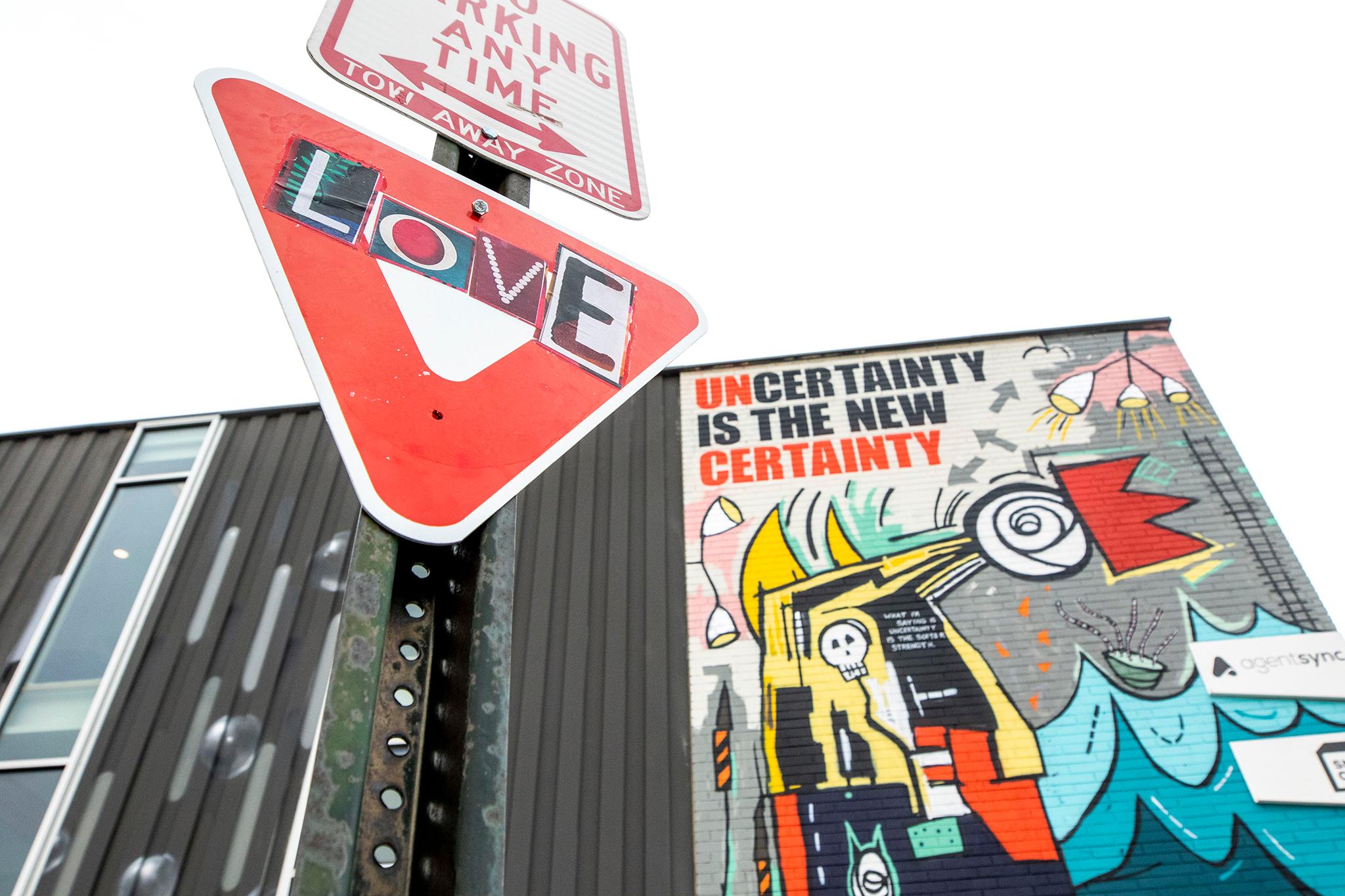
Vaughan has mixed feelings about RiNo's announcement that the split with Munro was mutual. She said she's glad something happened but is frustrated that she wasn't contacted as part of RiNo's investigation, if there was one. She said not much has changed since she and others came out against Munro in September.
"It just doesn't feel like it's enough," she said. "It feels like he still has power. I wish (RiNo) would talk a little bit more about their decision. I'm curious to see what will happen now, because as far as I know, he'll just continue doing the festival. So it's like, OK, what more can we do?"
The weekend after news broke that RiNo and CRUSH had ended their partnership, a love letter to the women in Denver's street art scene materialized on a wall just off of Larimer Street. The mural, a poem written by Galpin and wheatpasted using the color palette from Koko Bayer's "Pink Lemonade" hearts, asserted that the "women who color our city" belong here.
"This love letter was specifically written to celebrate, and to spread love for, the women who have been bullied and abused," Galpin said.
The timing of the mural was a coincidence, she said. It isn't about one individual. It's a response to this moment in Denver's street art scene in general, in which artists are grappling with issues of exclusion, abuse and harassment in their community.
Bayer and Galpin finished the piece around dusk on December 6 and left it still wet. By Monday morning, it had been tagged.
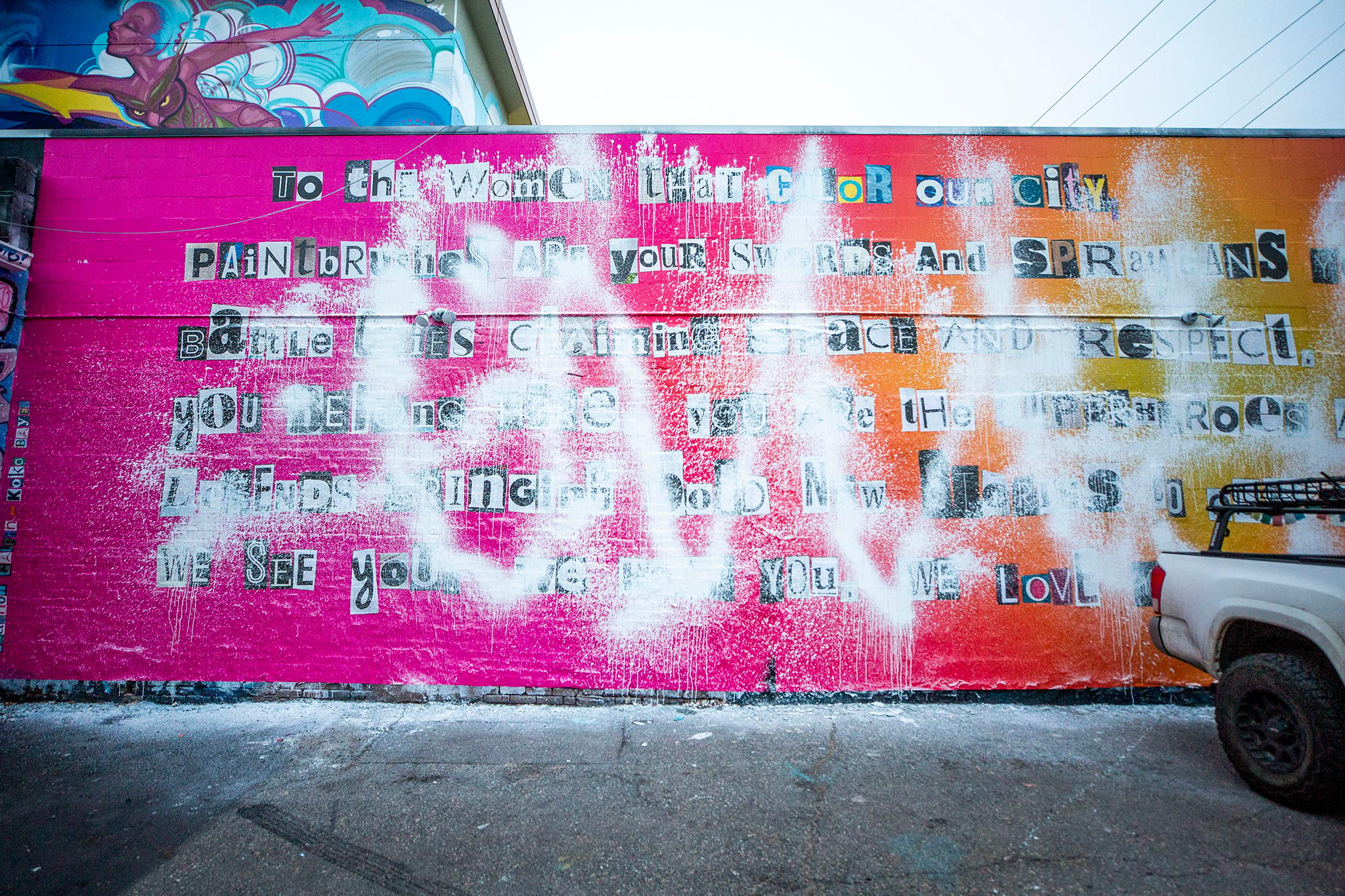
"It's just so indicative of the lack of respect," Galpin said. "If you're going to tag a massive tag on a wall that just went up about women claiming space and women painting our walls with our stories, then that shows that you don't think that we belong. You don't want us here. You are silencing women."
Bayer and Galpin repaired the mural on December 9. That night, someone whitewashed over it.
If you or someone you know is experiencing sexual assault or domestic violence, call the National Sexual Abuse Hotline at 800-656-4673 or Colorado Crisis Services at 844-493-8255.

